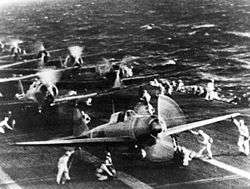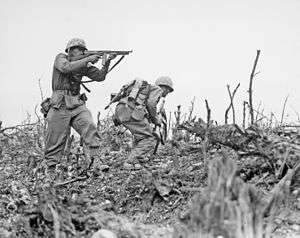Asiatic-Pacific Theater
The Asiatic-Pacific Theater, was the area of operations of U.S. forces during World War II in the Pacific War during 1941-45. From mid-1942 until the end of the war in 1945, there were two U.S. operational commands in the Pacific. The Pacific Ocean Areas (POA), divided into the Central Pacific Area, the North Pacific Area and the South Pacific Area,[1]:652–653 were commanded by Admiral Chester Nimitz, Commander-in-Chief Pacific Ocean Areas. The South West Pacific Area (SWPA), including New Guinea, Philippines, Borneo, and the Dutch East Indies, was commanded by General Douglas MacArthur, Supreme Allied Commander South West Pacific Area.[2] During 1945, the United States added the U.S. Strategic Air Forces in the Pacific, commanded by General Carl Spaatz.
Because of the complementary roles of the United States Army and the United States Navy in conducting war in the Pacific Theater, there was no single Allied or U.S. commander (comparable to General Dwight Eisenhower in the European Theater of Operations). There was no actual command; rather, the Asiatic-Pacific Theater was divided into the SWPA, the POA, and other forces and theaters, such as the China-Burma-India Theater.
Pacific Ocean Area major campaigns and battles


North Pacific Area
- Aleutian Islands Campaign, 1942–43
- Battle of the Komandorski Islands, March 1943[3]
Central Pacific Area
- Attack on Pearl Harbor, December 1941[3]
- Battle of Guam, December 1941
- Battle of Wake Island, December 1941[1]:651–652
- Doolittle Raid, April 1942[3]
- Battle of Midway, June 1942[3]
- Gilbert and Marshall Islands campaign, 1943–44
- Makin Island raid, August 1942[4]
- Battle of Tarawa, November 1943[3]
- Battle of Kwajalein, February 1944[1]:751
- Battle of Eniwetok, February 1944[5]
- Raid on Truk (Caroline Islands), February 1944
- Mariana and Palau Islands campaign, 1944
- Battle of Saipan, June 1944[1]:761
- Battle of the Philippine Sea, June 1944[1]:765
- Battle of Guam, July - August 1944
- Battle of Tinian, July - August 1944
- Battle of Peleliu, September - November 1944
- Battle of Angaur, September - October 1944
- Battle of Leyte Gulf, October 1944[nb 1]
- Battle of the Sibuyan Sea, October 1944[nb 2]
- Battle of Cape Engaño, October 1944[nb 3]
- Volcano and Ryukyu Islands campaign, 1945
- Battle of Iwo Jima, February 1945[3]
- Battle of Okinawa, April 1945[3]
South Pacific Area
- Guadalcanal Campaign, August 1942–February 1943
- Battle of Savo Island, 9 August 1942[1]:695
- Battle of the Eastern Solomons, 24–25 August 1942[1]:697
- Battle of Cape Esperance, 11–12 October 1942[1]:699
- Battle of the Santa Cruz Islands, 26 October 1942[1]:701
- Naval Battle of Guadalcanal. 12–15 November 1942[3]
- Battle of Tassafaronga, 30 November 1942[3]
- Solomon Islands Campaign, January 1942–November 1943
- New Georgia Campaign, June–August 1943
- Battle of Kula Gulf, 6 July 1943
- Battle of Kolombangara, 12–13 July 1943
- Battle of Vella Gulf, 6–7 August 1943
- Battle of Vella Lavella, August–October 1943
- Naval Battle of Vella Lavella: 6/7 October 1943
- Land Battle of Vella Lavella: 15 August – 9 October 1943
- Battle of Empress Augusta Bay, 1–2 November 1943
- Battle of Cape St. George, 25 November 1943
- Bougainville Campaign, November 1943 – April 1944 and on to August 1945
South West Pacific Area major campaigns and battles
- Philippines campaign, 1942
- Battle of Bataan, January–April 1942
- Battle of Corregidor, May 1942
- New Guinea campaign, 1942–45
- Battle of Rabaul, January–February 1942
- Invasion of Salamaua–Lae, March 1942
- Battle of the Coral Sea, May 1942
- Invasion of Buna-Gona, July 1942
- Kokoda Track campaign, July–November 1942
- Battle of Milne Bay, August–September 1942
- Battle of Goodenough Island, October 1942
- Battle of Buna–Gona, November 1942–January 1943
- Battle of Wau, January 1943
- Battle of the Bismarck Sea, March 1943
- Salamaua–Lae campaign, April–September 1943
- Finisterre Range campaign, September 1943–April 1944
- Huon Peninsula campaign, September 1943–March 1944
- Bougainville Campaign, November 1943–August 1945
- New Britain campaign, December 1943–August 1945
- Admiralty Islands campaign, February–May 1944
- Western New Guinea campaign, April 1944–August 1945
- Aitape–Wewak campaign, November 1944–August 1945
- Philippines campaign, 1944-45
- Battle of Leyte, October–December 1944
- Battle of Leyte Gulf, October 1944
- Battle of Palawan Passage, October 1944
- Battle of Surigao Strait, October 1944
- Battle off Samar, October 1944
- Battle of Mindoro, December 1944
- Battle of Lingayen Gulf, January 1945
- Battle of Luzon, January–August 1945
- Battle of Manila, February–March 1945
- Battle of Corregidor, February 1945
- Invasion of Palawan, February–April 1945
- Battle of the Visayas, March–July 1945
- Battle of Mindanao, March–August 1945
- Battle of Maguindanao, January–September 1945
- Borneo campaign, 1945
- Battle of Tarakan, May–June 1945
- Battle of North Borneo, June–August 1945
- Battle of Balikpapan, July 1945
China-Burma-India Theater major campaigns and battles[8]
- Burma, December 1942–May 1942
- India-Burma, April 1942–January 1945
- China Defensive, July 1942–May 1945
- Central Burma, January 1945–July 1945
- China Offensive, May1945–September 1945
Notes
- ↑ Note that the Battle of Leyte Gulf is listed in both the Central Pacific Area (under Nimitz) and in the South West Pacific Area (under MacArthur). Leyte Gulf is where Nimitz's western thrust across the central Pacific Ocean intersected MacArthur's northern thrust across the western Pacific Ocean. While the Pacific Ocean command structure was convoluted, operations were "designed to sequence the SWPA's operations with POA's forces across the central Pacific.[6]:IX-136The main purpose of sequencing is to arrange objectives/tasks in such a progression that collectively they lead to the accomplishment of the assigned ultimate objective in the shortest time possible and with the least loss of personnel and materiel."[6]:IX-135 Nimitz provided, but maintained control over, Admiral Halsey's Third Fleet to cover and support Admiral Kinkaid's Seventh Fleet operating under General MacArthur. The result of this imprecise arrangement was the crisis precipitating the Battle off Samar. Halsey was operating under Commander in Chief, Pacific Operating Area's (Nimitz') Operations Plan 8-44.[7]
- ↑ By US Navy's Third Fleet under Admirals Halsey and Nimitz.
- ↑ By US Navy's Task Force 38 under Admirals Mitscher and Nimitz.
Footnotes
- 1 2 3 4 5 6 7 8 9 Potter & Nimitz (1960).
- ↑ Douglas MacArthur as Supreme Commander SWPA
- 1 2 3 4 5 6 7 8 9 Silverstone (1968) pp.9-11.
- ↑ Kafka & Pepperburg (1946) p.185.
- ↑ Ofstie (1946) p.194.
- 1 2 Vego (2007).
- ↑ Vego (2006) pp. 126-130
- ↑ U.S. Army Center of Military History. "World War II - Asiatic-Pacific Theater Campaigns - U.S. Army Center of Military History". U.S. Army Center of Military History. U.S. Army Center of Military History. Retrieved 21 October 2015.
References
- Cressman, Robert J. (2000). The Official Chronology of the U.S. Navy in World War II. Annapolis, Maryland: Naval Institute Press. ISBN 1-55750-149-1.
- Drea, Edward J. (1998). In the Service of the Emperor: Essays on the Imperial Japanese Army. Nebraska: University of Nebraska Press. ISBN 0-8032-1708-0.
- Kafka, Roger; Pepperburg, Roy L. (1946). Warships of the World. New York: Cornell Maritime Press.
- Miller, Edward S. (2007). War Plan Orange: The U.S. Strategy to Defeat Japan, 1897–1945. US Naval Institute Press. ISBN 1-59114-500-7.
- Ofstie, Ralph A. (1946). The Campaigns of the Pacific War. Washington, D.C.: United States Government Printing Office.
- Potter, E. B.; Nimitz, Chester W. (1960). Sea Power: A Naval History (First ed.). Englewood Cliffs, NJ: Prentice-Hall, Inc.
- Silverstone, Paul H. (1968). U.S. Warships of World War II. Doubleday and Company.
- Hakim, Joy (1995). A History of Us: War, Peace and all that Jazz. New York: Oxford University Press. ISBN 0-19-509514-6.
- Vego, Milan N. (2007). Joint Operational Warfare: Theory and Practice. Newport, Rhode Island: United States Naval War College.
- Vego, Milan N. (2006). The Battle for Leyte, 1944: Allied and Japanese Plans, Preparations, and Execution. Annapolis, Maryland: Naval Institute Press.